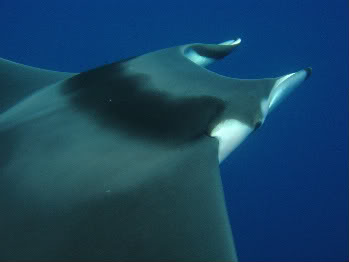|
|
The first global study of open ocean (pelagic) sharks and rays found that 32 percent of the species are threatened with extinction largely due to overfishing and bycatch, making pelagic sharks and rays more threatened than birds (12 percent), mammals (20 percent), and even amphibians (31 percent), which are considered to be undergoing an extinction crisis. The situation worsens when only sharks taken in high-seas fisheries are considered: 52 percent of these species are threatened.
“The completion of this global assessment of pelagic sharks and rays will provide an important baseline for monitoring the status of these keystone species in our oceans,” says Roger McManus, Vice-President for Marine Programs at Conservation International.
 The great hammerhead shark is listed as Endangered in the new IUCN list on open ocean sharks and rays. Photo by: Jeremy Stafford-Deitsch. |
Long killed by fisheries as bycatch, sharks have recently become targets of many high seas fisheries due to an increased demand for shark meat and fins. Shark fins are used in the Asian delicacy shark fin soup. When caught sharks often undergo ‘finning’, where the fins are sliced off the shark before its body is tossed overboard. While, finning has been banned in most international waters, there is currently little enforcement. Due to slow maturation and few offspring, sharks are particularly vulnerable to fishing.
“Despite mounting threats, sharks remain virtually unprotected on the high seas,” says Sonja Fordham, Deputy Chair of the IUCN Shark Specialist Group and Policy Director for the Shark Alliance. “The vulnerability and lengthy migrations of most open ocean sharks call for coordinated, international conservation plans. Our report documents serious overfishing of these species, in national and international waters, and demonstrates a clear need for immediate action on a global scale.”
 The giant devilray is listed as Endangered in the new IUCN list on open ocean sharks and rays. Photo by: Wurtz-Artescienza. |
With these findings the IUCN calls on governments to set catch limits for sharks and rays. In addition the organization urges nations to fully protect species considered Critically Endangered and Endangered. Finally, the IUCN would like to see an end to all shark finning, improved monitoring of fisheries involved in catching sharks, increased investment in shark and ray research, programs to minimize bycatch, and better cooperation between countries to protect pelagic sharks and rays, which are known to migrate long distances, and therefore need more than local protection.
The study further found that 24 percent of the species are Near Threatened and 25 percent Data Deficient, meaning there was insufficient information to make an assessment.
Shark status was determined by the International Union for Conservation of Nature (IUCN) Shark Specialist Group.
Status of individual species:
Endangered, 4 species
Ornate eagle ray Aetomylaeus vespertilio;
Giant devilray Mobula mobular ;
Scalloped hammerhead Sphyrna lewini ;
Great hammerhead Sphyrna mokarran.
Vulnerable, 16 species
Whale shark Rhincodon typus;
Smalltooth sand tiger Odontaspis ferox;
Pelagic thresher Alopias pelagicus;
Bigeye thresher Alopias superciliosus;
Thresher shark Alopias vulpinus;
Basking shark Cetorhinus maximus;
Great white Carcharodon carcharias;
Shortfin mako Isurus oxyrinchus;
Longfin mako Isurus paucus;
Porbeagle shark Lamna nasus;
Tope shark Galeorhinus galeus;
Oceanic whitetip shark Carcharhinus longimanus;
Dusky shark Carcharhinus obscurus;
Sandbar shark Carcharhinus plumbeus;
Night shark Carcharhinus signatus;
Smooth hammerhead Sphyrna zygaena.
Near threatened, 15 species
Frilled shark Chlamydoselachus anguineus;
Bluntnose sixgill shark Hexanchus griseus;
Spotted eagle ray Aetobatus narinari;
Manta Oceanic Manta birostris;
Spinetail devilray Mobula japanica;
Crocodile shark Pseudocarcharias kamoharai;
Silvertip shark Carcharhinus albimarginatus;
Bronze whaler Carcharhinus brachyurus;
Spinner shark Carcharhinus brevipinna;
Silky shark Oceanic Carcharhinus falciformis;
Galapagos shark Carcharhinus galapagensis;
Bull shark Carcharhinus leucas;
Blacktip shark Carcharhinus limbatus;
Tiger shark Semipelagic Galeocerdo cuvier;
Blue shark Prionace glauca.
Related articles
Whale sharks threatened by interbreeding

(04/08/2009) The world’s largest living fish, the whale shark, is threatened by interbreeding, according to a new study in PLoS ONE. Comparing the DNA of 68 individual whale sharks from eleven locations across the globe, geneticists found that the whale sharks had little genetic variation between the populations.
Sharks in trouble after nations fail to create sustainable management programs
(11/06/2008) Sharks are disappearing from the ocean at startling rates: currently one-in-five of these famous marine predators are threatened with extinction. According to a report from the Australian Government and TRAFFIC—an organization that monitors wildlife trade both legal and illegal—the collapse of shark populations is being caused largely by rising demand for shark fin in Asia. The report shows that legal fishing for sharks has become nearly as detrimental as illegal, since few fisheries have management strategies concerned with sustainability.
The long-ignored ocean emergency and what can be done to address it

(08/18/2008) This year has been full of bad news regarding marine ecosystems: one-third of coral species threatened with extinction, dead-zones spread to 415 sites, half of U.S. reefs in fair or bad condition, increase in ocean acidification, tuna and shark populations collapsing, and only four percent of ocean considered pristine. Jeremy Jackson, director of the Scripps Center for Marine Biodiversity and Conservation at the University of California, San Diego, synthesizes such reports and others into a new paper, published in the journal Proceedings of the Naional Academy of Sciences, that boldly lays out the scope of the oceanic emergency and what urgently needs to be done.